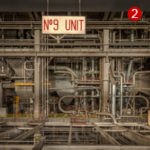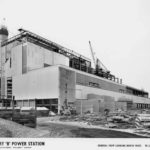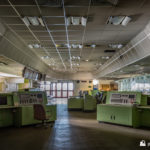
Construction of the first power station at Tilbury commenced in 1951 and Tilbury ‘A’ Station opened in 1956.

The original power station was mothballed in 1981 and was mostly demolished in 1999 – for a while small building housing ancillary services and the control room remained, however all traces have now been demolished.

Tilbury ‘B’ Station was constructed from 1961 and opened in 1968. The station consisted of four GEC generating units with a total capacity of 1428 MW. Fuel was delivered via ship to a huge jetty in the Thames. Cooling water was also drawn from the Thames.
The station was originally fuelled by coal but was converted to burn biomass in 2011. Only a couple of years later the announcement was made that the station was to be closed, and the station generated its last electricity in 2013. RWE cited a lack of government subsidiaries as the reason for this closure.
Buildings and Plant Detail

The control room at Tilbury had seen some upgraded but remained largely original.
Coal was delivered to Tilbury via a jetty with two large unloaders.
Tilbury Image Gallery
Visit the plant detail pages above to view more images from each area of the power plant
2012 Fire
On the morning of 27 February 2012 a major fire broke out in the station’s fuel storage area. Between 4,000 – 6,000 tonnes of fuel was being stored in the area at the time. Essex County Fire and Rescue Service mobilised over 120 firefighters to the fire, along with 15 pumping appliances, crews used three aerial ladder platforms, one major rescue tender, three bulk foam tenders and a thermal-imaging camera in a helicopter to help tackle the fire.





 Turbine Hall
Turbine Hall Boiler House & Fuel Delivery
Boiler House & Fuel Delivery Control Room & Admin
Control Room & Admin Jetty & Coal Unloaders
Jetty & Coal Unloaders









15 thoughts on “Tilbury B Power Station, Essex”
I worked at the B station from 1964 until 1979. It was a brilliant place to work but the plant did not offer many rewards for the effort needed to operate it.
A couple of corrections. The A station opened in 1956, not 1966 and the B station turbo generators were not Parsons but GEC Erith (Fraser & Chalmers works) products.
Hello,
I am researching the construction method used to make the power station chimneys. I believe they were made from concrete for the wind shields but I am looking to know what was inside the stacks. What were the flues make from and if there was other materials in the flues etc.
Any help is greatly appreciated.
A lot of experimental work for the GEC excitors was tested at Poole on the GEC sets.
Dear Lawrence, I was wondering if you knew my father Connell Doherty, his brother Denis Doherty and his friend John Carey all from Donegal. They were there from 1965 with Foster Wheeler and John Brown Boilers Ltd. Then EE Turbines up to 1974 when they went to the Isle of Grain (GEC).
Worked here from 2001 until closure and then with the decommissioning team until hand over to the demolition contractor. To secure a future Tilbury was always open to new initiatives and switched to high volatile coal and later to a full 100% biomass conversion which even required the Gas Turbines to be converted to burn Rapeseed Oil. The “can we do it, yes we can” attitude made it a great place to work. The staff loved a challenge.
I worked as a unit operator for 25 years retiring in 2013 on closure,
Including the period of change hard desk to soft desk,interesting times.
I worked at Tilbury B from1986 to 1990 as an MMD fitter. Previously worked at Acton lane and Willesden National grid sub station. I started as an apprentice at the bankside training centre in 1974. I left the board in 1990, soon after privatisation.
I worked on the construction of Tilbury B power station at the commencement to the completion of the station. I returned occassionaly working on the maintenance and repair jobs – It was a hard place of work with long hours of day and night shifts – The workers were tough hard working men, who possessed skill and daring. I enjoyed the work despite being a dangerous environment. Happy Days ” more stories to tell ” Len
I
Re Construction method.
The stack lining was acid resistant brickwork either Nori or Coalbrook, the jointing cement possibly Prodorite. Built in several sections each one sitting on concrete corbels.
I was a site engineer on the pumphouse construction. It was mainly built above ground and sunk – under its own weight and by grabbing the earth from within the cells – into position. The knife-edge bottoms of the cell walls initially sat on concrete blocks and when the structure was several metres tall, these blocks were to be split to allow the structure to penetrate the earth (Thames clay, actually). There was talk of the blocks being cracked by explosives and this operation was due to be filmed for TV. My boss decided to do it a little secretly, by the plug and feather method (a good name for a pub?), in case thinks went wrong. Fortunately they didn’t and the descent of the pumphouse was well-controlled.
Hi Graham,
I remember the construction of the pumphouse well in the cold winter of January through to A pril 1961 when we were snowed in. There were also challenges with pitching and driving 90′ steel sheet and box piles through the river wall. Tony
I worked on the installation of the turbines in 1963 when I was an apprentice at GEC Erith.
I was seconded to Tilbury from Brunswick Wharf , I was involved in the reconstruction of the 7 and 8 DC Aux Boards that had been destroyed in the cable race fire of 1977 , it was a perfect ending for my early retirement after 38 years in the industry , enjoyed every minute of it.
I was a maintenance mechanical shift fitter 1975-1996 mostly remember hot and dusty conditions, contrasted by freezing conditions when having to work on the jetty cranes but most of all, the great men I worked with.
I am trying to find anyone who may of worked with my dad Bernard stump
Be in 70’s to 80’s please